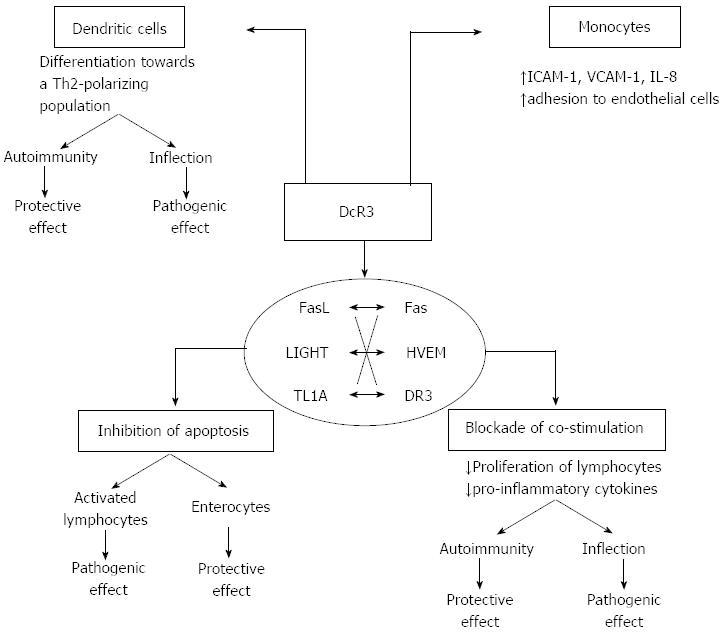Copyright
©2013 Baishideng Publishing Group Co.
Figure 1 Upregulation of Decoy receptor 3 in chronic inflammation.
Decoy receptor 3 (DcR3) exists solely as a secreted protein, which becomes detectable at the peripheral blood of patients with a variety of inflammatory conditions. The most stable associations have been described for gut and joint inflammation as well as for infectious diseases. DcR3 upregulation is mediated via diverse inflammatory stimuli, including pro-inflammatory cytokines [most prominently tumor necrosis factor-α (TNF-α)], bacterial-derived factors such as lipopolysaccharide (LPS) or lipoteichoic acid (LTA), and growth factors including epidermal growth factor and transforming growth factor-α, which interact with their respective receptors. Regulation is highly dependent upon the target cell population, although there is considerable overlap between the various targets. In monocytes and small intestinal epithelial cells LTA and LPS interact with TLR-2 and -4, whereas TNFα is a potent stimulator of DcR3 expression in various cell populations, including epithelial cells and keratinocytes. Nonetheless, a common final signalling pathway for DcR3 induction appears to be the activation of the transcription factor NF-kB. The latter is a final step that leads to the transcriptional activation of the tnfrsf6b gene and release of the DcR3 protein into the systemic circulation. EGF: Epidermal growth factor; TGF-α: Transforming growth factor-α; TLR: Toll like receptor; NF-kB: Nuclear factor of kappa light polypeptide gene enhancer in B-cells 1; EGFR: Epidermal growth factor receptor.
- Citation: Siakavellas SI, Bamias G. Decoy receptor 3: Its role as biomarker for chronic inflammatory diseases. World J Immunol 2013; 3(3): 44-53
- URL: https://www.wjgnet.com/2219-2824/full/v3/i3/44.htm
- DOI: https://dx.doi.org/10.5411/wji.v3.i3.44









